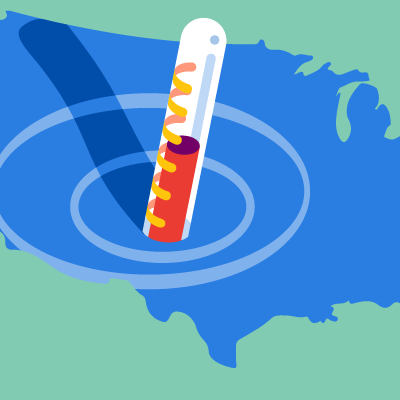While the west Coast of Canada is no stranger to wet weather—November is usually the wettest month of the year—a series of three atmospheric river events transported an unprecedented amount of tropical moisture to the region in November 2021.
The First Storm Inundates
From November 13 to 15 the first storm delivered record-breaking amounts of precipitation to B.C. and inundated neighboring Washington State, resulting in widespread flooding that damaged infrastructure and homes and displaced thousands of residents. The worst of the flooding impacts were noted on the Canadian side of the border.
A month’s worth of rain fell on B.C. in those first three days; almost 12 inches (300 mm) fell on the City of Hope, while southern locations in the province received 6-8 inches (150-200 mm). Soils already saturated following heavy rainfall in October and early November were unable to absorb the intense and long-lasting rainfall, and the resultant rapid runoff overwhelmed many streams and rivers. The rainfall also led to some snowmelt in the mountains, adding to the inundation.
Thousands of people were evacuated and homes and businesses were inundated, particularly in the southwestern corner of the province. Many roads became submerged or blocked by landslides, railway lines were washed out or blocked, and bridges were washed away, prompting B.C. to declare a state of emergency. In Abbotsford—the largest municipality in the province outside Metro Vancouver and located near the U.S. border and the Fraser River—a portion of Highway 1, a major artery, was rendered impassable by 2-foot-deep floodwaters. A landslide on Highway 99 left four people dead and rendered that road impassable.
Flooding Cuts Off Vancouver
Regional road and rail links to Vancouver—Canada’s third largest city, its largest and busiest port, and North America’s third-largest trade hub—were severed by flooding and landslides in the first storm. The city was effectively isolated from the rest of the country, halting the international exchange of manufactured goods, food, fuel, lumber, and grains. Some road and rail links to Vancouver were briefly restored, only to be shut down again in subsequent storms.
The port normally moves around CAD 550 million of cargo daily, but even before the floods, it had been struggling to get through the backlog of ships and containers due to impacts from the COVID-19 pandemic and summer wildfires—a situation that worsened when the port was repeatedly cut off from the mainland. Even when container ships are successfully unloaded, there is less space to store and refill containers due to congestion and flooding, resulting in many containers being sent back to Asia, according to port officials, and the resultant traffic snarl will take months to untangle.
Truckers have been forced to idle in wait for containers, often fruitlessly. Transportation is also hampered by fuel shortages stemming in part from a flood-prompted three-week shutdown of the Trans Mountain oil pipeline, leading to weeks of gas rationing.
Storms Two and Three Allow Little Time for Recovery
Almost two weeks later, on November 27 and 28, a second atmospheric river brought more torrential rain to B.C.; Hope saw 5.5 inches (140 mm) of precipitation and a third event two days later dropped even more, with up to 190 mm falling around Metro Vancouver. In total, an estimated 19 inches (500 mm) of rain fell on parts of B.C. that week. In the higher elevations, a significant amount of that moisture fell as snow, bringing avalanche risks, with some snow subsequently melting during the record high temperatures that followed on December 1.
Damage to dikes, infrastructure, businesses, and homes in the first storm only worsened the flood impacts in these subsequent events. Swollen waterways again overtopped their banks, and thousands of residents were forced to evacuate around the Coquihalla, Sumas, Tulameen, Similkameen, Coldwater, Lower Nicola, Chilliwack, and Fraser rivers. Closures on major arteries such as Highway 1 and 3 again isolated Vancouver from the rest of the province. In total, at least 200 highways were affected by shutdowns and damage from flooding and landslides. Highway 1 and some transportation links were reopened but B.C.’s Minister of Transportation has stated that the repair work needed for widespread damage to highways and bridges will be “significant.”
Record-Breaking Precipitation and an Atmospheric River Ranking System
The province broke records for the wettest day and wettest November, quickly followed by the hottest December temperature of 72.5°F (22.5°C), bringing snowmelt that fed the floods. The first storm alone broke at least 20 rainfall records across B.C. In Washington State, the Seattle area saw 1.5 to 3 times the normal precipitation amounts for November, with Bellingham experiencing the wettest November on record with at 14.57 total inches of rain, nearly three inches higher than the previous record.
Environment and Climate Change Canada (ECCC) has been developing a new atmospheric river ranking system to warn the public of the potential impacts of incoming events, although it won’t be ready to launch for “some years” according to the ECCC’s most recent statements. According to the agency’s internal testing, the first of the three atmospheric river events could have qualified as an AR5, the highest possible ranking.
Hazard Maps
For the insurance industry and the Canadian government, these events have highlighted the need for their ongoing work on developing proactive strategies for mitigation and planning to reduce flood risk, including addressing the impacts of urban floodplain development.
A useful first step in risk assessment is a detailed hazard map. These maps indicate the associated risks for perils such as inland flood for a range of return periods, such as 100, 250, and 500 years. The Geospatial Analytics Module in AIR’s Touchstone® platform lets you seamlessly integrate exposure information with location-specific hazard maps, including flood inundation footprints for Canada. As the insurance industry in Canada continues to cope with recent losses, the development of risk maps and probabilistic models as well as a deeper understanding of underlying hazards can help provide more effective risk management.




